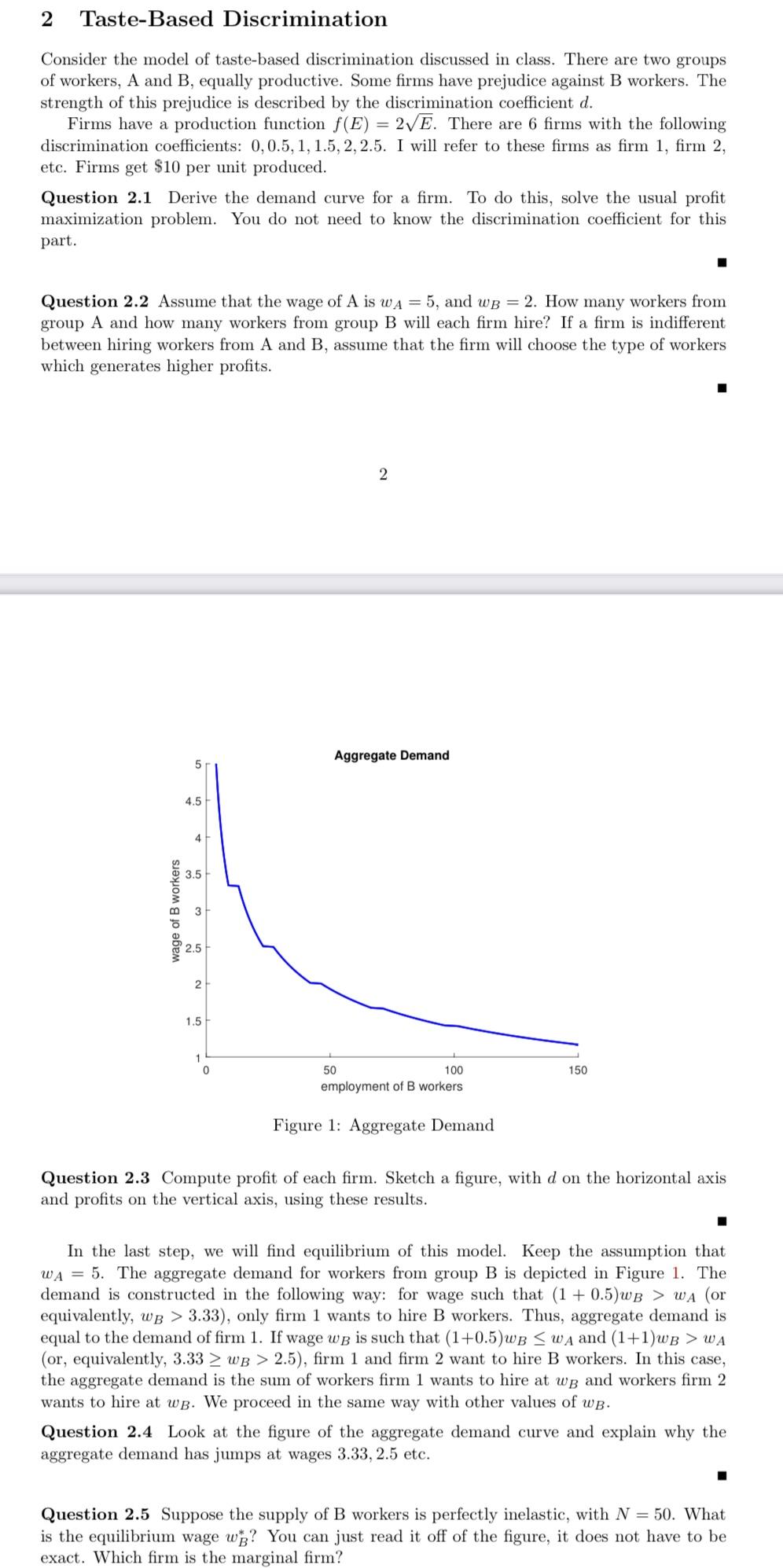
2 Taste-Based Discrimination Consider the model of taste-based discrimination discussed in class. There are two groups of workers, A and B, equally productive. Some firms have prejudice against B workers. The strength of this prejudice is described by the discrimination coefficient d. Firms have a production function f(E)= 2E. There are 6 firms with the following discrimination coefficients: 0, 0.5, 1, 1.5, 2, 2.5. I will refer to these firms as firm 1, firm 2, etc. Firms get $10 per unit produced. Question 2.1 Derive the demand curve for a firm. To do this, solve the usual profit maximization problem. You do not need to know the discrimination coefficient for this part. Question 2.2 Assume that the wage of A is wA = 5, and wg = 2. How many workers from group A and how many workers from group B will each firm hire? If a firm is indifferent between hiring workers from A and B, assume that the firm will choose the type of workers which generates higher profits. 2 Aggregate Demand 5 4.5 4 wage of B workers 2.5 2 1.5 1 0 50 100 150 employment of B workers Figure 1: Aggregate Demand Question 2.3 Compute profit of each firm. Sketch a figure, with d on the horizontal axis and profits on the vertical axis, using these results. In the last step, we will find equilibrium of this model. Keep the assumption that WA 5. The aggregate demand for workers from group B is depicted in Figure 1. The demand is constructed in the following way: for wage such that (1+0.5)wB> WA (or equivalently, wB > 3.33), only firm 1 wants to hire B workers. Thus, aggregate demand is equal to the demand of firm 1. If wage wp is such that (1+0.5)WB WA and (1+1)WB > WA (or, equivalently, 3.33 WB > 2.5), firm 1 and firm 2 want to hire B workers. In this case, the aggregate demand is the sum of workers firm 1 wants to hire at wg and workers firm 2 wants to hire at wg. We proceed in the same way with other values of wg. Question 2.4 Look at the figure of the aggregate demand curve and explain why the aggregate demand has jumps at wages 3.33, 2.5 etc. Question 2.5 Suppose the supply of B workers is perfectly inelastic, with N = 50. What is the equilibrium wage w? You can just read it off of the figure, it does not have to be exact. Which firm is the marginal firm? 2 Taste-Based Discrimination Consider the model of taste-based discrimination discussed in class. There are two groups of workers, A and B, equally productive. Some firms have prejudice against B workers. The strength of this prejudice is described by the discrimination coefficient d. Firms have a production function f(E)= 2E. There are 6 firms with the following discrimination coefficients: 0, 0.5, 1, 1.5, 2, 2.5. I will refer to these firms as firm 1, firm 2, etc. Firms get $10 per unit produced. Question 2.1 Derive the demand curve for a firm. To do this, solve the usual profit maximization problem. You do not need to know the discrimination coefficient for this part. Question 2.2 Assume that the wage of A is wA = 5, and wg = 2. How many workers from group A and how many workers from group B will each firm hire? If a firm is indifferent between hiring workers from A and B, assume that the firm will choose the type of workers which generates higher profits. 2 Aggregate Demand 5 4.5 4 wage of B workers 2.5 2 1.5 1 0 50 100 150 employment of B workers Figure 1: Aggregate Demand Question 2.3 Compute profit of each firm. Sketch a figure, with d on the horizontal axis and profits on the vertical axis, using these results. In the last step, we will find equilibrium of this model. Keep the assumption that WA 5. The aggregate demand for workers from group B is depicted in Figure 1. The demand is constructed in the following way: for wage such that (1+0.5)wB> WA (or equivalently, wB > 3.33), only firm 1 wants to hire B workers. Thus, aggregate demand is equal to the demand of firm 1. If wage wp is such that (1+0.5)WB WA and (1+1)WB > WA (or, equivalently, 3.33 WB > 2.5), firm 1 and firm 2 want to hire B workers. In this case, the aggregate demand is the sum of workers firm 1 wants to hire at wg and workers firm 2 wants to hire at wg. We proceed in the same way with other values of wg. Question 2.4 Look at the figure of the aggregate demand curve and explain why the aggregate demand has jumps at wages 3.33, 2.5 etc. Question 2.5 Suppose the supply of B workers is perfectly inelastic, with N = 50. What is the equilibrium wage w? You can just read it off of the figure, it does not have to be exact. Which firm is the marginal firm







